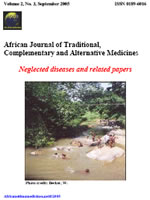
|
African Journal of Traditional, Complementary and Alternative Medicines
African Ethnomedicines Network
ISSN: 0189-6016
Vol. 12, No. s1, 2015, pp. 52-61
|
 Bioline Code: tc15130
Bioline Code: tc15130
Full paper language: English
Document type: Review Article
Document available free of charge
|
|
|
African Journal of Traditional, Complementary and Alternative Medicines, Vol. 12, No. s1, 2015, pp. 52-61
| en |
ANTI-INFLAMMATORY MEDICINAL PLANTS AND THE MOLECULAR MECHANISMS UNDERLYING THEIR ACTIVITIES
Nworu, Chukwuemeka Sylvester & Akah, Peter Achunike
Abstract
Background: Medicinal plant and plant products have shown tremendous potentials and are used beneficially in the treatment of inflammation
and in the management of diseases with significant inflammatory components. Many medicinal plants employed as anti-inflammatory and antiphlogistic
remedies lack the gastro-erosive side effects of non-steroidal anti-inflammatory drugs (NSAID) or the plethora of unwanted side
effects associated with steroidal anti-inflammatory drugs. In order to harness and optimise the applications of these herbs in inflammatory
diseases, there is a need to understand how these herbs produce their anti-inflammatory actions.
Materials and Methods: This paper is a review of some anti-inflammatory herbs and their molecular mechanisms of action. A literature search
and analysis of published manuscript was employed to x-ray research findings that show how medicinal plants produce anti-inflammatory
activities.
Results: Many studies have shown that anti-inflammatory activities of herbal extracts and herb-derived compounds are mainly due to their
inhibition of arachidonic acid (AA) metabolism, cyclo-oxygenase (COX), lipo-oxygenase (LOX), pro-inflammatory cytokines, inducible nitric
oxide, and transcription activation factor (NF-κB). Some anti-inflammatory medicinal herbs are reported to stabilize lysosomal membrane and
some cause the uncoupling of oxidative phosphorylation of intracellular signalling molecules. Many have also been shown to possess strong
oxygen radical scavenging activities.
Conclusion: Most of the mechanisms by which anti-inflammatory medicinal plants act are related and many herbal products have been shown to
act through a combination of these molecular pathways.
Keywords
Medicinal plants; antiinflammatory; mechanism of action; molecular pathways
|
| |
© Copyright 2015 - African Journal of Traditional, Complementary and Alternative Medicines
Alternative site location: http://journals.sfu.ca/africanem/index.php/ajtcam
|
|
